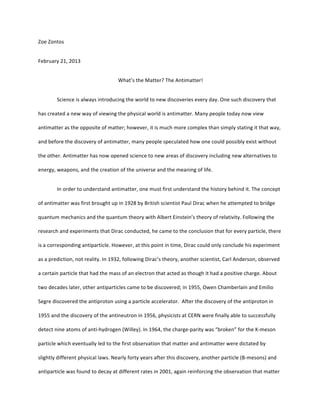More Related Content
Similar to Antimatter (19)
More from Zoe Zontou (14)
Antimatter
- 1. Zoe Zontos
February 21, 2013
What’s the Matter? The Antimatter!
Science is always introducing the world to new discoveries every day. One such discovery that
has created a new way of viewing the physical world is antimatter. Many people today now view
antimatter as the opposite of matter; however, it is much more complex than simply stating it that way,
and before the discovery of antimatter, many people speculated how one could possibly exist without
the other. Antimatter has now opened science to new areas of discovery including new alternatives to
energy, weapons, and the creation of the universe and the meaning of life.
In order to understand antimatter, one must first understand the history behind it. The concept
of antimatter was first brought up in 1928 by British scientist Paul Dirac when he attempted to bridge
quantum mechanics and the quantum theory with Albert Einstein’s theory of relativity. Following the
research and experiments that Dirac conducted, he came to the conclusion that for every particle, there
is a corresponding antiparticle. However, at this point in time, Dirac could only conclude his experiment
as a prediction, not reality. In 1932, following Dirac’s theory, another scientist, Carl Anderson, observed
a certain particle that had the mass of an electron that acted as though it had a positive charge. About
two decades later, other antiparticles came to be discovered; in 1955, Owen Chamberlain and Emilio
Segre discovered the antiproton using a particle accelerator. After the discovery of the antiproton in
1955 and the discovery of the antineutron in 1956, physicists at CERN were finally able to successfully
detect nine atoms of anti-hydrogen (Willey). In 1964, the charge-parity was “broken” for the K-meson
particle which eventually led to the first observation that matter and antimatter were dictated by
slightly different physical laws. Nearly forty years after this discovery, another particle (B-mesons) and
antiparticle was found to decay at different rates in 2001, again reinforcing the observation that matter
- 2. and antimatter have different properties. Fermi National Accelerator Laboratory then came to discover
a change-parity in 2010 that was about fifty times larger the effect of the change-parity found in K-
mesons and B-mesons previously; this discovery would come to contradict the standard model of
particle physics (Hellemans). And then, in November of 2010, there was a breakthrough at CERN:
physicists were successful in creating and capturing the first forms of antimatter for about one-sixth of a
second (“Breakthrough”).
What exactly is antimatter, and why is it important? Antimatter is much more complex than
simply saying that it is the opposite of matter. Following the discovery of the first particle of antimatter,
the positron, the reality of antimatter now supports the evidence that every particle must result in a
corresponding and opposite antiparticle. The production of both is possible anytime there is sufficient
energy given to create a balance of mass-energy. However, the properties and the laws of physics that
govern matter are slightly different from the properties and laws of physics when concerning
antimatter. Antimatter does not last long; when antimatter and matter come into contact, the two
annihilate each other, thus, making it difficult to currently produce and maintain any amount of
antimatter for prolonged periods of time. For the most part, matter and antimatter have symmetry;
however, the small asymmetry that is present correlates with the fact that matter outlives antimatter in
the universe (“What Is Antimatter?”). Antimatter is important in understanding how the universe was
created and what was occurring as the universe was being formed (if one is a supporter of the Big Bang
Theory). Now that antimatter has been discovered, the question of why matter was not destroyed and
why most antimatter was destroyed following the birth of the universe will hopefully become more lucid
(“Origins”). Other reasons for the importance of the discovery and creation of antimatter lie in
alternative energy sources and the future of space travel. Antimatter can potentially have the capacity
to provide large amounts of energy while taking up small amounts of space. Since antimatter can
produce large quantities of energy in relatively tiny amounts, the future of energy and travel is

